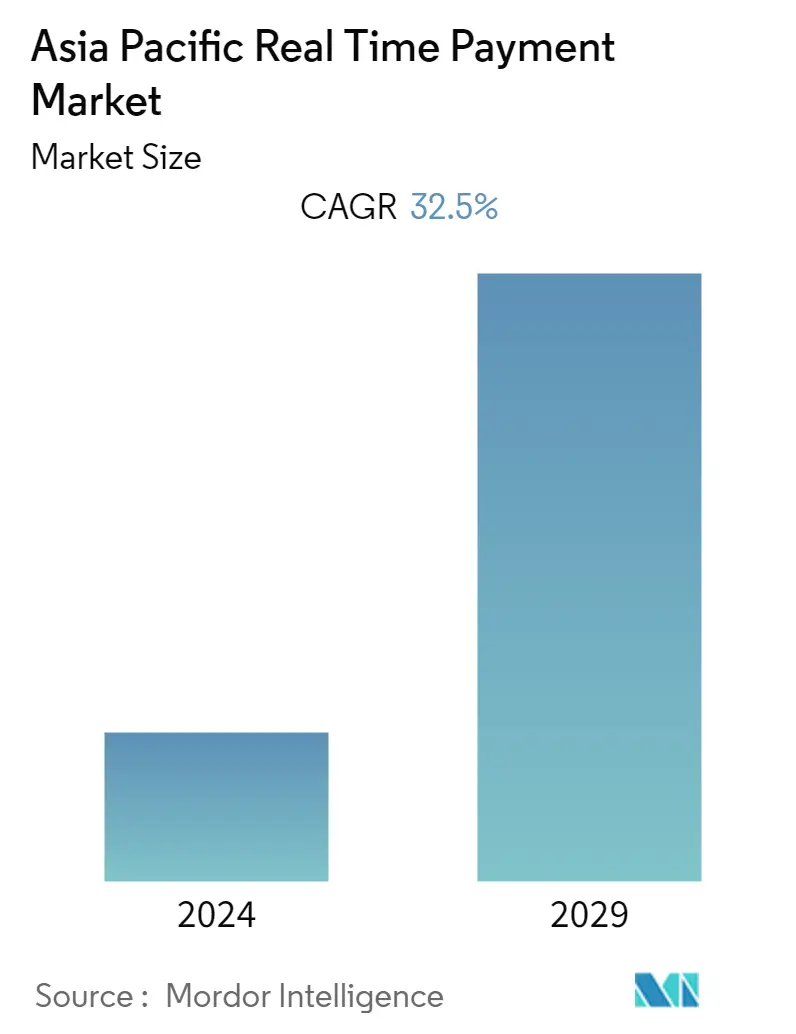Market Size of Asia Pacific Real Time Payment Industry

| Study Period | 2019 - 2029 |
| Base Year For Estimation | 2023 |
| Forecast Data Period | 2024 - 2029 |
| Historical Data Period | 2019 - 2022 |
| CAGR | 32.50 % |
| Market Concentration | Medium |
Major Players
*Disclaimer: Major Players sorted in no particular order |
APAC Real Time Payment Market Analysis
Asia Pacific Real-Time Payment Market is expected to grow by 32.5% CAGR in the forecasted period. The growing number of smartphone users around the region and the faster transaction speeds compared to alternative methods are propelling the market forward. Over the forecast period, increased acceptance of real-time payment solutions among retailers and retail shop owners is expected to boost market expansion. Although, cybersecurity worries and the difficulties encountered during financial transfers are two factors that may have a detrimental impact on market growth.
- Consumers, businesses, and governments in emerging nations such as India, China, Thailand, Vietnam, etc., are adopting quick payments to gain greater ease and financial security, driving up demand for the solutions.
- The market is primarily supported by the growing use of cell phones worldwide and the ever-increasing desire for quick clearing and reimbursement of money transactions between vendors and purchasers. Furthermore, the market is predicted to develop due to the growing acceptance of real-time payment solutions by web-based business sellers and retail location owners. These systems offer advantages such as faster transaction speeds than other electronic techniques, real-time communications, extensive data transactions, and vendor and corporate organization accessibility 24 hours a day, seven days a week.
- Additionally, rising volumes of cashless transactions and a growing shopper preference for systems like net and mobile banking will add to industry expansion. Due to the increasing popularity of FinTech administrations such as Samsung Pay, Google Pay, and Apple Pay, the industry is likely to grow significantly. Furthermore, expanding the combined efforts of these services/service organizations and regional banks to launch advancements, such as the provision of speedy advances and money-less payments, would accelerate the industry even further.
- According to ACI Worldwide and the Centre for Economics and Business Research's research, Globaldata's Prime-Time for Real-Time 2022, (Cebr). Thailand was the fourth-largest country in the world regarding real-time transactions, with 9.7 billion. In 2021, widespread adoption of real-time payments was expected to save businesses and consumers USD 1.3 billion, resulting in USD 6 billion in additional economic production, representing 1.12% of the country's GDP.
- Lockdowns imposed as a result of COVID-19 enhanced e-commerce and food apps, driving the real-time payments business as well. Real-time payments, for example, accounted for 31.3 percent of overall payments transaction volume in India in 2021, according to ACI, owing to merchant acceptance of UPI-based mobile payment apps and QR code payments, as well as increasing use of digital payments during the Covid-19 outbreak.
APAC Real Time Payment Industry Segmentation
Real-time payments are instant or immediate payments and are defined by the Euro Retail Payments Board (ERPB) as electronic retail payment solutions that are available 24/7/365. Immediate payments enable businesses and consumers to make and receive payments in real-time, providing convenience, speed, and faster availability of funds.
Asia Pacific Real-Time Payment Market is segmented by Type (P2P, P2B) and by Country (China, India, Japan, South Korea, and the Rest of the Asia-Pacific).
| By Type of Payment | |
| P2P | |
| P2B |
| Asia Pacific | |
| China | |
| India | |
| Japan | |
| South Korea | |
| Rest of the Asia Pacific |
Asia Pacific Real Time Payment Market Size Summary
The Asia Pacific real-time payment market is experiencing significant growth, driven by the increasing number of smartphone users and the demand for faster transaction speeds. This market expansion is further supported by the growing acceptance of real-time payment solutions among retailers and businesses across the region. Emerging economies such as India, China, Thailand, and Vietnam are at the forefront of this shift, as consumers, businesses, and governments seek greater convenience and financial security. The rise of cashless transactions and the popularity of FinTech services like Samsung Pay, Google Pay, and Apple Pay are also contributing to the market's growth. However, challenges such as cybersecurity concerns and issues during financial transfers could potentially hinder progress.
The competitive landscape of the Asia Pacific real-time payment market is characterized by the presence of numerous regional players and the influx of investments due to rapidly changing consumer preferences. The market is becoming increasingly fragmented as new entrants seek to capitalize on its vast growth potential. Strategic partnerships and collaborations are being formed to drive product innovation and enhance service offerings. The introduction of 5G technology and the expansion of digital solutions in line with Industry 4.0 goals are expected to further boost the market. Key players like ACI Worldwide, Fiserv, PayPal, and Mastercard are actively involved in shaping the market dynamics through strategic alliances and technological advancements.
Asia Pacific Real Time Payment Market Size - Table of Contents
-
1. MARKET INSIGHTS
-
1.1 Market Overview
-
1.2 Industry Attractiveness-Porter's Five Force Analysis
-
1.2.1 Bargaining Power of Suppliers
-
1.2.2 Bargaining Power of Buyers/Consumers
-
1.2.3 Threat of New Entrants
-
1.2.4 Threat of Substitute Products
-
1.2.5 Intensity of Competitive Rivalry
-
-
1.3 Evolution of the payments landscape in the country
-
1.4 Key market trends pertaining to the growth of cashless transaction in the Region
-
1.5 Impact of COVID-19 on the payments market in the country
-
-
2. Market Segmentation
-
2.1 By Type of Payment
-
2.1.1 P2P
-
2.1.2 P2B
-
-
2.2 Asia Pacific
-
2.2.1 China
-
2.2.2 India
-
2.2.3 Japan
-
2.2.4 South Korea
-
2.2.5 Rest of the Asia Pacific
-
-
Asia Pacific Real Time Payment Market Size FAQs
What is the current Asia Pacific Real Time Payment Market size?
The Asia Pacific Real Time Payment Market is projected to register a CAGR of 32.5% during the forecast period (2024-2029)
Who are the key players in Asia Pacific Real Time Payment Market?
ACI Worldwide, Fiserv, PayPal, Mastercard and FIS are the major companies operating in the Asia Pacific Real Time Payment Market.

